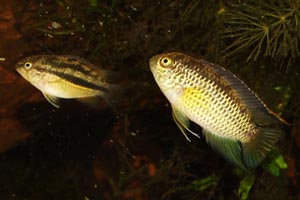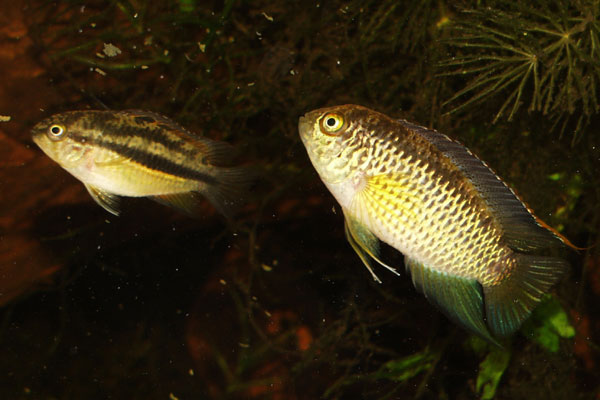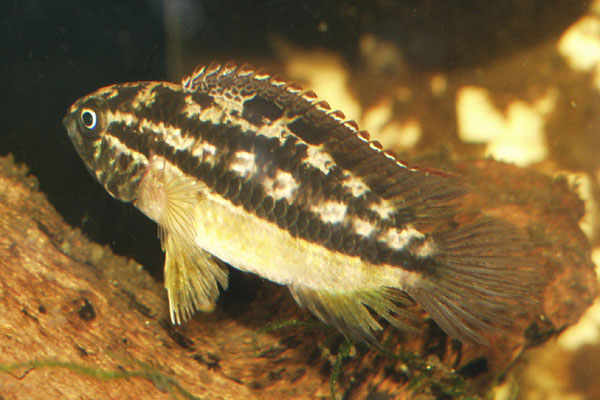

Species Profile | Images | Breeding Report | Similar Species

(Other members of the genus Nannacara)
ADULT SIZE: 5 cm
WATER CONDITIONS: Moderately soft and acidic
TEMPERATURE RANGE: 23-27 C
FOOD: Feed Nannacara anomala small live-foods and fine grade dried foods
DISTRIBUTION: This species comes from Guyana
AQUARIUM CARE: This peaceful cichlid is ideal for a community tank; thy are not aggressive and will accept most foods. Include some planted areas and caves in their tank decor.
BREEDING: Breeding the Nannacara anomala is relatively simple. Well feed fish breed readily; spawning in a cave (an overturned terracotta flower pot works well). The male fish will guard the territory whilst the female tends the fry.
Have you bred Nannacara anomala? Why not fill in a breeding questionaire?, or examine existing Nannacara anomala breeding reports
Other members of the genus Nannacara
Other cichlid species
Other species from Guyana

This pair clearly demonstrate the size and colouration differences of each of the sexes

A female showing characteristic checkerboard breeding colouration
BREEDING: Breeding the Nannacara anomala is relatively simple. Well feed fish breed readily; spawning in a cave (an overturned terracotta flower pot works well). The male fish will guard the territory whilst the female tends the fry.
Have you bred Nannacara anomala? Why not fill in a breeding questionaire?
This page summarises breeding reports provided by visitors to this site, along with some statistical analysis. Please feel free to contribute - whatever your experience!
| |||||||||
|
| ||||||||
|
| ||||||||
|
| ||||||||
|
| ||||||||
Remember, each record represents only one persons experience; if you had different results, or used different methods, please share your experiences
| Water conditions: Moderately hard and alkaline | Water temperature: 24-27oC |
| Disposition: Somewhat aggresive on occasions | Community tank?: Yes, a good community fish |
| Spawning Method: Long term (fry appear with adults) | Breeding problems: Poor egg survival |
| Sex ratio: Somewhat male heavy | Breeding difficulty: Average |
| Sucess: Average | Years Experience: 1 |
| Other Comments: I have had two spawns of nannacara anomala. I maintain a pair in a 40 gallon breeder with ten neon tetras and 8 beckfords pencilfish. Initially the female was agressive towards the male after spawning, as she was protecting her eggs. However both times when the fry became free swimming, both the male and female would parade the fry around the aquarium in seperate groups. I had not known of this behavior existing previously among the species. | |
| Date this record created: 9th May 2019 | Breeding date: 2019 |
| Breeder: Joey Roldan | Location: Austin, TX |
| Water conditions: Moderately hard and alkaline | Water temperature: 24-27oC |
| Disposition: Slightly timid | Community tank?: Yes, a good community fish |
| Spawning Method: Long term (fry appear with adults) | Breeding problems: none |
| Sex ratio: | Breeding difficulty: Easy |
| Sucess: Average | Years Experience: 1 |
| Other Comments: | |
| Date this record created: 18th December 2012 | Breeding date: 2012 |
| Breeder: | Location: |
| Water conditions: Moderately soft and acidic | Water temperature: 24-27oC |
| Disposition: Slightly timid | Community tank?: Only with species of similar size |
| Spawning Method: Other (see below) | Breeding problems: Poor fry survival rate |
| Sex ratio: Roughly equal | Breeding difficulty: Easy |
| Sucess: Average | Years Experience: 4 |
| Other Comments: Nannacara anomala spawn routinely in the community tank. However, if left unchecked, the fry will be eaten by other fish, specially when the mother is young. I'd suggest raising the fry in a separate tank. This tank should have some leaf litter and moss to feed the fry in the first days. After that they should be fed with Liquifry or similar. | |
| Date this record created: 12th January 2012 | Breeding date: 2011 |
| Breeder: | Location: |